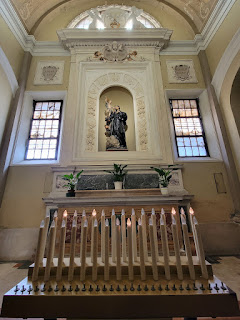Day 86: Ravenna Italy Day 2
Today we did "Tours by Locals" that was set up by a fellow passenger. It was called: Explore Ravenna Unesco Full Day Highlights
A short ride from the port into town
In this tour we have the opportunity of seeing six Unesco Monuments with the most beautiful complete and antique mosaics in the world, Roman and Byzantine.
We started with the Mausoleum of Theodoric
https://en.wikipedia.org/wiki/Mausoleum_of_Theodoric
The mausoleum's current structure consists of two decagonal orders, one above the other made of Istrian stone, sourced from a quarry approximately 400 kilometres (249 mi) away by land journey. The mausoleum's roof consists of a single carved stone 10 metres (33 ft) in diameter weighing 230 tonnes. A niche leads down to a room that was probably a chapel for funeral liturgies; an external stair leads to the upper floor. Located in the centre of the upper floor is a fragmentary ancient Roman porphyry tub, likely from a bath complex, in which Theodoric was buried. His remains were removed during Byzantine rule, when the mausoleum was turned into a Christian oratory. In the late 19th century, silting from a nearby rivulet that had partly submerged the mausoleum was drained and excavated.
Basilica of San Vitale and the nearby Mausoleum of Galla Placidia (both we saw yesterday)
https://en.wikipedia.org/wiki/Basilica_of_San_Vitale
The Basilica of San Vitale is a late antique church in Ravenna, Italy. The sixth-century church is an important surviving example of early Christian Byzantine art and architecture.
The church's construction began in 526 on the orders of Bishop Ecclesius of Ravenna. At the time, Ravenna was under the rule of the Ostrogoths. Bishop Maximian completed construction in 547, preceding Justinian's creation of the Exarchate of Ravenna, which followed his partial re-conquest of the Western Roman Empire.
A small part of the original mosaic floor
https://en.wikipedia.org/wiki/Mausoleum_of_Galla_Placidia
The Mausoleum of Galla Placidia is a Late Antique Roman building in Ravenna, Italy, built between 425 and 450.[1] It was added to the World Heritage List together with seven other structures in Ravenna in 1996.[2] Despite its common name, the empress Galla Placidia (d. 450) was not buried in the building, a misconception dating from the thirteenth century;[3] she died in Rome and was buried there,[4] probably alongside Honorius in the Mausoleum of Honorius at Old Saint Peter's Basilica.[5]
------------------------------------
Walking around town
We thought someone had left a coat on a bench but realized that it was all part of an art statue
A local man
Dante's Tomb
https://en.wikipedia.org/wiki/Dante_Alighieri
Dante Alighieri (Italian: [ˈdante aliˈɡjɛːri]; c. 1265 – 14 September 1321), probably baptized Durante di Alighiero degli Alighieri[note 1] and often referred to as Dante (English: /ˈdɑːnteɪ, ˈdænteɪ, ˈdænti/,[2][3] US: /ˈdɑːnti/[4]), was an Italian[a] poet, writer and philosopher.[6] His Divine Comedy, originally called Comedìa (modern Italian: Commedia) and later christened Divina by Giovanni Boccaccio,[7] is widely considered one of the most important poems of the Middle Ages and the greatest literary work in the Italian language.[8][9]
------------------------------------------------------------------------
The Basilica of Francesco was where Dante went to church and is next door to his tomb
With Ravenna's water table being just under the surface and some of the land used to be water but has silted over the centuries, many of the building have settled and have water in their lower floor. This particular has an area under the alter where you can view the water. They actually have goldfish in the water.
It was Palm Sunday and we found out that they pass out olive leaves instead
The lights for the water area had a slot that you put 1 Euro in for the lights to come on. They also had a animated nativity scene that cost 1 Euro.
---------------------------------------------------------------------
San Apollinare Nuovo
https://en.wikipedia.org/wiki/Basilica_of_Sant%27Apollinare_in_Classe
The Basilica of Sant'Apollinare Nuovo is a basilica church in Ravenna, Italy. It was erected by the Ostrogothic king Theodoric the Great as his palace chapel during the first quarter of the 6th century (as attested to in the Liber Pontificalis). This Arian church was originally dedicated in 504 AD to "Christ the Redeemer".[1]
Some of the lambs was pure white (symbolizing without sin)
and some were speckled (that were still with sin)
San Apollinare in Classe
The Basilica of Sant' Apollinare in Classe ("Saint Apollinaris in Classe") is a church in Classe, Ravenna, Italy, consecrated on 9 May 549 by the bishop Maximian and dedicated to Saint Apollinaris, the first bishop of Ravenna and Classe. An important monument of Byzantine art, in 1996 it was inscribed with seven other nearby monuments in the UNESCO World Heritage List, which described it as "an outstanding example of the early Christian basilica in its purity and simplicity of its design and use of space and in the sumptuous nature of its decoration". (https://en.wikipedia.org/wiki/Basilica_of_Sant%27Apollinare_in_Classe)
A Cow art exhibit in Pope John Paul II Park in front of the church. Not sure if many under 40 have ever used a phone booth but there is one here
Inside the church
This church had portraits of all the bishops when the church was built. This one now has the pope hat emblem over it since this bishop became pope later.
Mosaics studio
Dinner


Back to port
As we got up to the ship, the captain got on the ship's intercom and told us that a storm brewing was going to produce high winds along the mountain range to the west of us. And there would be areas where it would funnel through the mountain passes and come out to the coast. Right where two of our next ports were planned. The first one Ljubljana (Koper), Slovenia was a tender port and by afternoon would be very windy. The Tuesday port, Split, Croatia, would be in the middle of the worst of the wind. so he made the decision to skip these ports. We will head down to our Wednesday port of Kotor Montenegro.





































































.jpg)
















































beautiful churches and doors.So glad your captain keeps his eye on the weather.sorry you missed two more ports
ReplyDelete